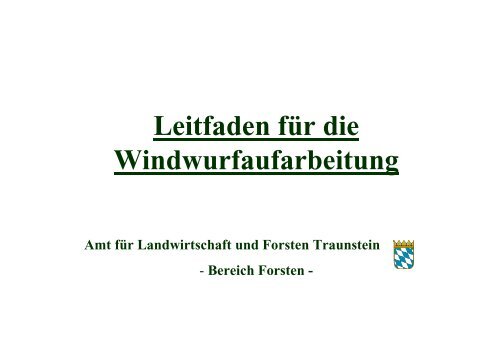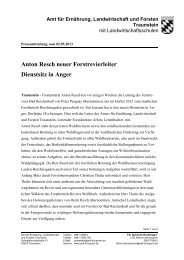Leitfaden für die Windwurfaufarbeitung - Amt für Ernährung ...
Leitfaden für die Windwurfaufarbeitung - Amt für Ernährung ...
Leitfaden für die Windwurfaufarbeitung - Amt für Ernährung ...
Erfolgreiche ePaper selbst erstellen
Machen Sie aus Ihren PDF Publikationen ein blätterbares Flipbook mit unserer einzigartigen Google optimierten e-Paper Software.
(a) DisallowedR1: friends[a].add(b) R2: v = wall[a].get // {post}wall[a].add(post) w = friends[a].get // ∅ωfa.add(b)so vis, arωwa.add(post)ωwa.get: {post}soωfa.get: ∅(b) Allowed, even when using transactionsR1: wall[a].add(post1 ) R2: wall[b].add(post2 )v = wall[b].get // ∅ w = wall[a].get // ∅ωwa.add(post1)soωwb.get: ∅ωwb.add(post2)soωwa.get: ∅(c) DisallowedR1: atomic { R2: atomic {friends[a].add(b) v = friends[a].get // {b}friends[b].add(a) } w = friends[b].get // ∅ }ωfa.add(b)soωfb.add(a)vis, arωfa.get: {b}soωfb.get: ∅Fig. 1. Anomalies illustrating the semantics of causal consistency and causally consistent transactions.The outcomes of operations are shown in comments. The variables v and w are local toclients. The structures shown on the right are explained in §3.2.Eventually consistent stores adopt an architecture where a replica performs an operationrequested by a client locally without any synchronisation with others and immediatelyreturns to the client; the effects of the operation are propagated to other replicasonly eventually. As a result, different replicas may find out about an operation at differentpoints in time. This leads to anomalies, one of which is illustrated by the outcomein Figure 1(a). The program shown there consists of two clients operating on set objectsfriends[a] and wall[a], which represent information about a user a in a socialnetwork application. The first client, connected to replica 1, makes b a friend of a’sand then posts b’s message on a’s wall. After each of these operations, replica 1 mightsend a message with an update to replica 2. If the messages carrying the additions of bto friends[a] and post to wall[a] arrive at replica 2 out of order, the second client cansee b’s post, but does not know that b has become a’s friend. This outcome cannot beproduced by any interleaving of the operations shown in Figure 1(a) and, hence, is notstrongly consistent.The consistency model of a replicated store restricts the anomalies that it exhibits.In this paper, we consider the popular model of causal consistency [16], a variant ofeventual consistency that strikes a reasonable balance between programmability andefficiency. A causally consistent store disallows the anomaly in Figure 1(a), because itrespects causal dependencies between operations: if the programmer sees b’s post to a’swall, she is also guaranteed to see all events that led to this posting, such as the additionof b to the set of a’s friends. Causal consistency is weaker than strong consistency; inparticular, it allows reading stale data. This is illustrated by the outcome in Figure 1(b),which cannot be produced by any interleaving of the operations shown. In a causallyconsistent store it may be produced because each message about an addition sent by thereplica performing it may be slow to get to the other replica.Due to such subtle semantics, writing correct applications on top of eventually consistentstores is very difficult. In fact, finding a good programming model for eventual
Gewusst wie!• Diese Schulung wendet sich an dengeschulten Anwender• Diese Information versteht sich alsErinnerungshilfe• Die 10 Standartsituationen• Dieser <strong>Leitfaden</strong> hilft keinem Anfänger!
Situation1: Normal geworfener Baum
Situation1: Normal geworfener Baum
Situation 2: Normal geworfener Baum
Situation 2: Normal geworfener Baum
Situation 2: Normal geworfener Baum
Situation 3: Normal geworfener Baum
Situation 3: Normalgeworfener Baum
Situation 3: Normalgeworfener Baum
Situation 4: Stamm steht unter Spannung undschnellt nach dem Trennschnitt hoch
Situation 4: Stamm steht unter Spannung undschnellt nach dem Trennschnitt hoch
Situation 5: Baum mit Seitenspannung
Situation 5: Baum mit Seitenspannung
Situation 6: Vorhänger
Situation 6: Vorhänger
Situation 7: Aufhänger
Situation 7: Aufhänger
Situation 7: Aufhänger
Situation 8: In Brusthöhe gebrochenerBaum
Situation 8: In Brusthöhe gebrochenerBaum
Situation 9: Über Brusthöhe abgebrochenerBaum
Situation 9: Über Brusthöhe abgebrochenerBaum
Situation 9: Über Brusthöhe abgebrochenerBaum
Situation 10: Fällung eines Baumstumpfes
Merke:• Sicherheit muss stets vor Schnelligkeit gehen. Die Unfallzahlensprechen eine deutliche Sprache.• Ich muss jeden einzelnen Baum/Stamm/Ast auf seineSpannungsverhältnisse und seine Gefährlichkeit genauestensbeurteilen.• Sind <strong>die</strong> Verhältnisse im Verhau zu komplex, muss ichversuchen,- mit Baggerhilfe zu entzerren oder- meinen Standplatz dadurch zu sichern, dass ich <strong>die</strong>bedrohlichen Stämme und Äste über Seilsicherung daranhindere, in meinem Standplatz hineinzuschlagen.• Nur wenn ich mir über <strong>die</strong> Schnittfolge und über meinensicheren Standplatz vor dem 1.Schnitt klar bin, kann ich denTrennschnitt von sicherer Stelle vollziehen.• Am Hang plane ich <strong>die</strong> Schnittfolge so, dass ich denTrennschnitt immer von der Bergseite her ausführen kann.
Merke:• Falls ich nur wenige Stämme mit Seilhilfe aufarbeiten muss undmir dazu kein Forstschlepper zur Verfügung seht, muss ich aufden Seilzug ausweichen.• Splintschnitte lege ich nur bei gesundem langfasrigen Holzartenan und nur dann, wenn ich be<strong>für</strong>chten muss, dass das Holzunkontrolliert aufreißen könnte.• Im Verhau arbeite ich in Wurfrichtung und am Hangstreifenweise in Falllinie von oben nach unten.• Beim Entzerren mit Seilhilfe arbeite ich im Verhau nur allein.Die Funkferngesteuerte Winde betätige ich erst, wenn ich denGefahrenbereich ausreichend weit verlassen habe.• Beim Entzerren in Zweimannarbeit geht der Motorsägenführer inden Verhau um das Seil anzuschlagen und <strong>die</strong>Schneidetechniken durchzuführen. Erst auf ein vereinbarteseindeutiges Handzeichen, darf der Windenführer <strong>die</strong> Winde inBetrieb setzen. Vorsicht beim Entspannen des Seils und bei dennachfolgenden Schritten.















